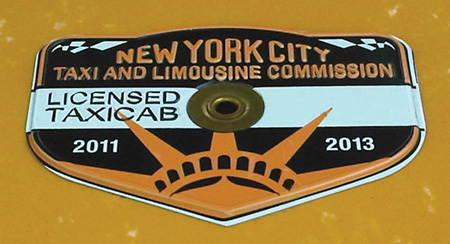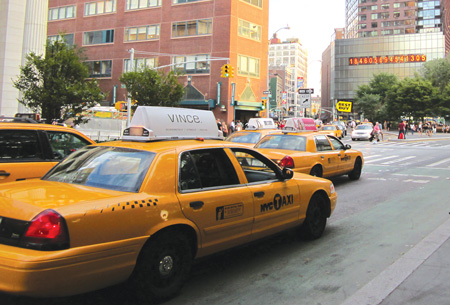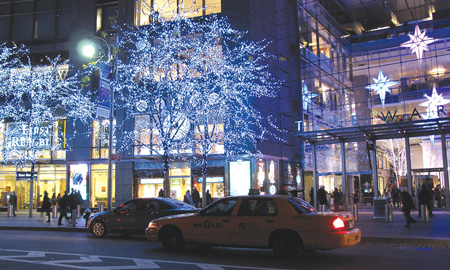 |
IN FOCUS |
by Matthew W. Daus, Esq.
President, International Association of Transportation Regulators
Distinguished Lecturer, University Transportation Research Center, Region 2
Contact: mdaus@windelsmarx.com • 156 West 56th Street, New York, NY 10019
T. 212.237.1106 • F. 212.262.1215 |
 |
NEW YORK CITY MEDALLION AUCTION RECAP – THE PAST, PRESENT AND FUTURE IMPACT ON THE TAXICAB AND FOR-HIRE VEHICLE INDUSTRIES

?One of the higher performing assets one can purchase is still a New York City taxicab medallion, and the latest medallion auction has demonstrated both strong demand and market prices. When I took over as TLC Commissioner/Chair in 2001, medallion market prices were in the $200,000 range, and when I eventually left the TLC in 2010 the prices increased thereafter almost five fold to over $1 million per medallion.
The reasons for those asset value increases are many including:
- holding several “competitive bid” auctions under my watch for only the second time since the Great Depression helping drive up prices;
- successful efforts to alleviate once and for all the taxi driver shortage of the 1990s culminating with a record number of licensed taxicab drivers that continues to this date;
- a once stable regulatory environment;
- the competitive pricing nature of sealed bid auctions;
- well timed fare increases that have continued the living wage trend started in 2004 with steady cash flow for owners and drivers;
- technology and service improvements;
- low interest rates and the list goes on and on.
We are, however, now at a crossroads. There has been so much regulatory unrest that I believe the primary forces holding up the prices are the fact that the driver pool, ridership (tourism) and industry finances are strong. A pending leadership change signals that investors are still very much interested in paying top dollar.
There are two key issues for the new Mayor and his administration that are critical to ensuring the health and stability of the medallion industry:
(1) “geo-fencing” – the strict enforcement and enhanced penalties to ensure green “boro taxis” do not illegally operate outside their defined territories; and
(2) sound policymaking regarding key issues such as technology, smartphone apps, and the types of vehicles to be used as yellow taxicabs.
Although there has been much discussion and litigation about the Street Hail Livery Law that is scheduled to allow up to 18,000 Street Hail Livery vehicles, which are also known as “boro taxis”, the law also provided that the New York City Taxi and Limousine Commission (the “TLC”) issue by public sale up to 2,000 fully transferrable taxicab medallions in addition to the 13,237 medallions already on the streets today.
The Street Hail Livery Law sought to address two key issues:
- the lack of accessible vehicles for New York City residents and non-residents with disabilities, and
- the lack of availability of yellow cabs in the four (4) boroughs outside Manhattan as well as in Manhattan, outside of Manhattan’s central business district (CBD).
Manhattan’s CBD, along with JFK and LaGuardia airports, are demarked as the “HAIL Exclusionary Zone,” in which Street Hail Licensed vehicles are prohibited from initiating passenger rides.
When the amended law was passed in February 2012, the NY State Legislature required that all of these new medallions be restricted for use with wheelchair-accessible taxicabs. The 2,000 new accessible medallions will represent an approximate 15% increase in the amount of taxicabs in the New York City taxicab fleet, and a recent lawsuit settlement may lead to up to one-half of the entire taxicab fleet becoming wheelchair accessible.
Almost immediately, litigation was initiated by industry stakeholders to enjoin the program from going forward. After one year of litigating the matter, the TLC was ultimately victorious and able to initiate the program after a unanimous decision was issued on June 6, 2013 by New York State’s highest court upholding the Street Hail Livery Law.
In September 2013, the TLC posted its required public notice that it would begin the process of adding these 2,000 medallions to the NYC fleet by holding an auction of 200 corporate (mini-fleet) wheelchair-accessible medallions. I was invited to a stakeholders’ meeting at the TLC in August at which time the TLC discussed the process for the auction.
The sealed bids would be submitted in envelopes that contained the bidder’s price for 2 accessible medallions along with a down payment and a commitment letter from a qualified lender. These requirements are set forth in the TLC rules, and remained largely unchanged since we implemented these rules while I was the Chair at the TLC. I was pleased that the TLC’s staff recommended not changing a thing about the auction process that we put into place years ago and the results so far have proved successful for all involved.
On November 14, 2013, the TLC held a public bid opening for its auction of 200 Corporate (Mini-Fleet) Wheelchair-Accessible Taxicab Medallions at the Tribeca Performing Arts Center, Borough of Manhattan Community College.
The opening of the sealed bids in a public setting with the oversight of the New York City Department of Investigation was also a process implemented under my watch to ensure that there was transparency. With the technological abilities available today, the TLC was also able to broadcast the opening of the sealed bids live via the TLC website:
- Each medallion had a minimum upset price of $850,000 per medallion or $1,700,000 per lot.
- Sealed bids were accepted by the TLC on November 7, 8, 12, and 13, 2013.
- Bids were considered acceptable and valid if they included a signed bid application with the minimum upset price of $1,700,000,
- a deposit of $5,000 per medallion ($10,000 deposit per envelope), and
- a commitment letter (or letters) from a licensed lending institution providing financing for at least 80% of the winning bid.

Photo: Elena Michaels
The top 100 bids were accepted as tentative winning bids, and the next ten (10) bids were held in reserve in the order of their bid amounts. They have the potential to be converted to a winning bid in the event that a winning bidder is disqualified or fails to complete the purchase. A total of 245 bid packages were submitted to the TLC. Of these, nine (9)
were deemed invalid for failure to fulfill all of the TLC’s bid application requirements.
When all the counting was done the two highest winning bids were for a combined $2,518,000, or $1,259,000 per accessible medallion. The lowest winning bid was $2,050,000 (or $1,025,000 per accessible medallion). There were nine (9) winning bids at this level. Three bids for the same amount were held in reserve since they were the 101st, 102nd, and 103rd bids from the 100 pairs that were made available by the TLC.
An additional seven bids were held in reserve in the order of the bid amount with a bid price ranging from $2,027,700 to $2,000,100. The 109th and 110th bids, which were tied with a bid amount of $2,000,100, were decided by a drawing held at the conclusion of the auction. These bid amounts were record breaking for the TLC even with the “restriction” that these medallions could only be used with wheelchair-accessible vehicles.
So what is next? Medallion auction sales will begin to take place in the three months after the auction as bidders schedule closings and obtain the financing for the purchases. The TLC informed stakeholders that additional time may be granted for the purpose of “hacking-up” the vehicles as they are retrofitted to be wheelchair-accessible.
Of note, even though the rules require that the bidders submit a commitment letter for at least 80 percent of the bid amount, the potential purchasers are not “locked in” for that loan amount or even with the same lender that provided the commitment letter. So, for example, if a purchaser wants to borrow less than the amount in the commitment or borrow nothing for an all-cash purchase, that would be acceptable.
Assuming that all the sales go forward, the City of New York will realize slightly less than $230 million from the auction which is an important cash infusion, as well as a good indication of the “current” stability of the yellow medallion values in New York City.
As the sales of these 200 accessible medallions are completed, the TLC has already informed stakeholders that it will conduct the public auction of the next group of 200 accessible medallions in the spring of 2014. In fact, the City has included the income from the sale of 400 medallions in the budget for its current fiscal year ending on June 30, 2014.
For the next sale, the TLC has already informed stakeholders that it will also be including independent medallions as well as corporate medallions. It should be noted that the TLC is not permitted under State law to authorize more than 400 of the 2000 accessible medallions until such time as the Disability Accessibility Plan (DAP) is approved by the NY State Department of Transportation. Of course, the next and any future auctions of the accessible medallions would be conducted in the new administration of Mayor-elect de Blasio.

Photo: Elena Michaels
So what do all of these developments mean for the future of all of the TLC’s regulated industries? In large part, this will be determined by the actions of the new Administration. While the promise of political and management change and a strong medallion industry has allowed for a successful auction, the future remains uncertain.
The Final Environmental Impact Statement issued by the TLC contains many statements that are conclusory and devoid of critical and comprehensive analysis, especially in the socio-economic impact section of the report. The potential impact on medallion asset values as well as on other regulated industries that could occur by the following contingencies were not fully or properly addressed, or not addressed at all:
(1) non-enforcement or ineffective enforcement on green boro taxis of the Street Hail Exclusionary Zone;
(2) the impact of the E-hail taxicab pilot program;
(3) the introduction of rogue and legal smartphone apps in the black car and limousine industry;
(4) the impact of 18,000 green boro taxi permits;
(5) the impact on the livery, limousine and black car industry’s assets and businesses by the introduction of additional medallion taxicabs.
There are so many unanswered questions and new developments that a first order of business, which may even be legally required, is for the TLC to issue a Supplemental EIS to address these issues to provide current and prospective medallion owners, as well as other industries, with a complete picture and landscape.
There is also much talk about whether green boro taxis will become mini-medallions? That could happen over time, but there is a long way to go. Sound policy making and enforcement coupled with proper entry limitations may lead to positive green taxi valuations. In my view they are more likely to mirror the value of black car cooperative shares or franchises (radio rights) as opposed to yellow taxicab values.
Yes, there is a problem –and it needs to be addressed. I have witnessed illegal pick-ups first hand in the CBD by green taxicabs, and there is no known enforcement initiative at this time. It is just a matter of time before yellow taxi drivers start to migrate to the green cab industry if this lack of enforcement continues.
All stakeholders, including those who fought for the street hail livery law, recognize and agree that these rules must be enforced. Meanwhile, the black car and limousine industry is under attack and completely lost in the shuffle with increased taxi usage due to credit cards, smartphone apps and the prolonged recessionary impact having taken a toll on these important businesses.
We need equity by and between our industries, policymaking across transportation sub-mode borders, and a new day for ground transportation regulation. That day is near, and the de Blasio administration is poised to settle the unrest and take our industries to higher levels of efficiency, service and success. Our Mayor-Elect has a thorough understanding, appreciation and concern for these issues, and I am confident customers, all of our regulated industries and drivers will be pleased in the coming years.
-
Senate Bill S5825 available at http://open.nysenate.gov/legislation/bill/S5825-2011.
-
Assembly Bill A8691A-2011 available at http://open.nysenate.gov/
legislation/bill/A8691A-2011.
-
As this article was going to print, the TLC announced a settlement of the “Taxis for All” litigation, which was a federal class action lawsuit brought in the Southern District of New York by disability advocates who challenged the TLC for failing to meet ADA requirements since there are only 231 accessible taxicabs in the New York City taxicab fleet. Even with the additional 2,000 accessible medallions contemplated as part of the Street Hail Livery Law, less than 15 percent of the New York City taxicab fleet would be wheelchair-accessible. The TLC and the plaintiffs have reached a settlement that, ultimately, one-half of the New York City taxicab fleet would be wheelchair-accessible. This would be achieved through the addition of the 2,000 accessible medallions and the replacement of a portion of the current non-accessible vehicles with wheelchair-accessible vehicles as those non-accessible vehicles reach the required retirement age. The TLC will need to adopt rules as part of this settlement, which will not take place until 2014.
-
After holding public hearings on the new proposed rules in March and April 2012, the Commissioners of the TLC voted on the proposed Street Hail Livery Rules at the April 19th hearing and adopted the rules by a 7 to 2 margin. Almost immediately after the TLC adopted these rules, litigation was initiated by medallions owners, which resulted in the program being enjoined by Justice Arthur Engoron of the New York State Supreme Court in Manhattan. He found that the Street Hail Livery Law violated the “home rule” provision of the New York State Constitution since the New York City Council had not acted in this “local” matter. After Judge Engoron issued his final decision on August 17, 2012 invalidating the law, the TLC and the plaintiffs all agreed to an expedited review of the case and asked the New York State Court of Appeals – the state’s highest court – to accept the case and bypass the intermediate appellate court. The Court of Appeals agreed, and heard arguments in April 2013. On June 6, 2013, the Court of Appeals issued a unanimous decision that overturned each of the trial court’s findings that invalidated the law. As a result, the TLC was able to immediately implement all parts of the Street Hail Livery Law, including beginning the process for the public sale of 2,000 accessible taxicab medallions.
-
See TLC Rules, Section 65-05.
-
See TLC Rules, Section 65-06.
© 2014 TLC Magazine Online, Inc. |



